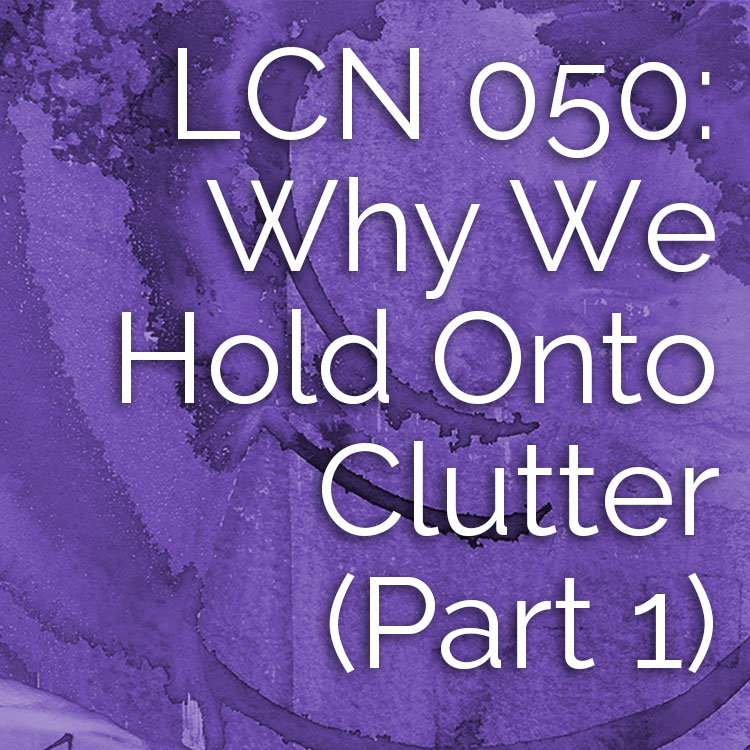
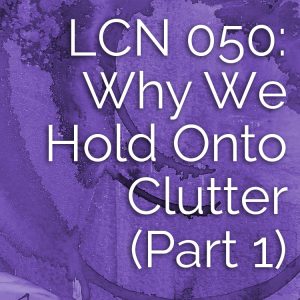 What gets in the way of releasing clutter? A lot, it turns out! (Shouldn’t be surprising, I guess, since so many people have clutter problems. Me included!)
What gets in the way of releasing clutter? A lot, it turns out! (Shouldn’t be surprising, I guess, since so many people have clutter problems. Me included!)
Today I’m sharing Part 1 of a two-part series on the seemingly sensible reasons why we hold onto clutter, and how to get past them, so you can let go of stuff that isn’t serving you.
In Part 1, I look at four common excuses for keeping our crap, and how to reframe them to help you let go.
Enjoy!
 In a couple of weeks I’m running another session of my Great ClutterBust — a community Spring cleaning party on steroids.
In a couple of weeks I’m running another session of my Great ClutterBust — a community Spring cleaning party on steroids.
The Great ClutterBust was responsible for clearing metric tons of clutter from the homes (and yards and cars) of dozens of members.
It is what enabled me to finally declutter over twenty years of accumulated clutter and transform my Studio of Doom into a studio I love.
In fact, I created the Great ClutterBust out of a sense of desperation.
I spend most of my time in my studio — if I’m not at my treadmill desk working on my iMac, I’m at my art table. And until the Great ClutterBust, I would cringe every time I walked in the door.
The sight of all that stuff weighed on me so heavily. It made me feel disorganized. Out of control. Incompetent. And depressed.
For years I’d wanted to clear it out, but the task seemed monstrous. Impossible.
Finally, last Spring, I leveraged what I knew about making big projects happen (including the six keys I teach in my free webinar, 6 Keys to Eliminate Procrastination and Unlock Kickass Productivity), in order to create the optimal conditions for success.
I very intentionally designed the Great ClutterBust to include:
- A supportive community (to encourage each other, provide inspiration, and help each other stay on track).
- Scheduled times to do the work (including live calls where we got to check in about what we were going to focus on during this particular block of time).
- Deadlines (built into the live calls, because we would report back on the other end!)
- External accountability (i.e., people to report back to, to make sure we actually did the work as scheduled!)
It worked like magic. Little by little (and in some cases, big chunks by big chunks) I cleared stuff out, carted it away, liberated floor- and airspace, and ultimately overhauled my entire studio (including hacking a new treadmill desk from Ikea parts)!
Here are my favorite before and after pictures:

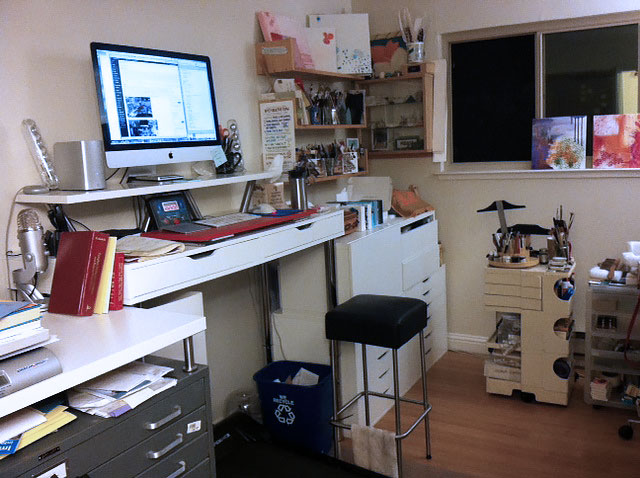
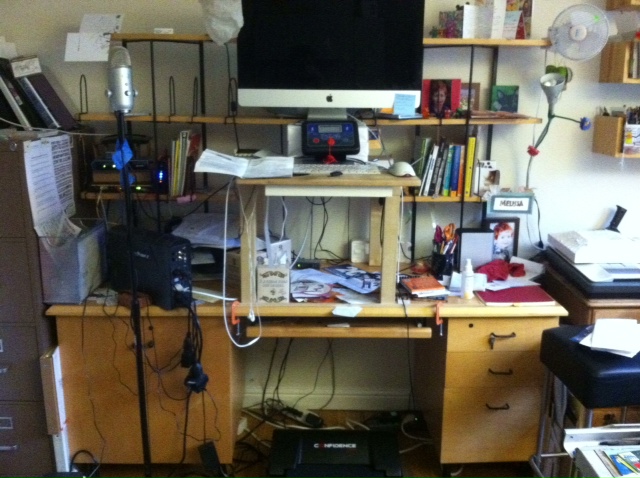
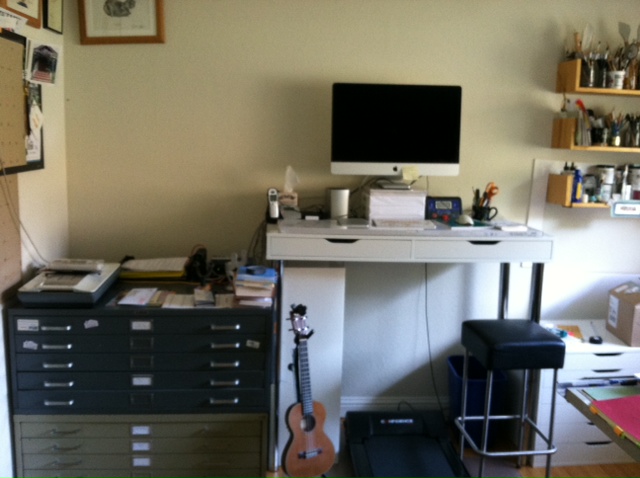
I won’t kid you: it took a ton of work to get from “before” to “after.” I could not have done it without the Great ClutterBust, and the awesome support and encouragement from everyone in the group.
For one thing, a huge project like this doesn’t happen overnight, and thanks to the Great ClutterBust, I finally made the time.
Even more important, though, was the emotional support.
See, clearing clutter isn’t just a matter of putting in time. There are deep-rooted emotions tied to our stuff, and unless and until we deal with the emotions, there’s no way we can get rid of the stuff!
The emotions get permanently bonded to stories — false narratives — that make shedding what’s no longer serving us feel not just impossible, but even harmful.
But the truth is, when you clear your space of stuff that’s not truly serving you, not only does it transform your environment, it changes your life!
Releasing physical objects that contain within them emotions, beliefs, and identities, frees us up to allow new storylines to come in.
It’s powerful juju. But it’s not always easy to see the stories, let alone dredge up the courage to do something about them. So let’s shine a light on them, shall we?
In Part 1 of this two-part series, here are four common excuses, and the stories that come with them, which may be preventing you from shedding your own clutter, along with some possible responses.
1. “I might need it someday.”
OMG! How much stuff have I held onto because of these five innocuous-sounding words?
Ask yourself, though, if you’ll really, truly need it. Then ask if your “maybe someday” need is more important to you than the glorious space you’ll be liberating.
Believe me, I love stuff. But unless it’s something that brings me joy or delight, or is useful to me on a regular basis, I have come to value space more highly than stuff.
Plus, remember, whatever it is you’re hesitant to let go if, it’s likely that you can borrow or rent something similar, if you really do have a need for it someday.
Or you can sit with the idea of (gasp!) just making do without it. (This might even lead you to new creative heights! After all, necessity is the mother of invention, right?)
If you’re still reluctant to let go, you might find the perspective of one of the members last year’s Spring Great ClutterBust useful.
She had just cleared out several houses of deceased relatives and friends, which gave her a new perspective on stuff and its value in our lives.
“Everything is borrowed,” she said, “even our bodies. Everything we own is like a book checked out of the library, and you can’t check out ALL the books, after all!”
With that in mind, I found it easier to let go of things.
Though I will confess that yes, I let go of two things last year that I really did need later: a brayer and a hot gun, neither of which I had used, and both of which ended up being on the supply list for a class I signed up for a mere week or two after selling them at a yard sale.
Doh!
Sigh… I’ll admit I was peeved for a moment, until some Facebook friends pointed out that the $25 I spent to replace them was a small price to pay for a cleared-out studio!
Besides, that brayer and hot gun went to people who would give them a lot more love and use than I had. When I release things “back to the wild” where they will do more than just take up space, it helps relieve the anxiety I feel from their loss.
2. “My mom/sister/brother/aunt/friend gave it to me.”
Ooh… This one is tough, isn’t it? How many well-intended gifts have occupied dead space in my house? Aiaiai!
Marie Kondo’s philosophy on this helped me enormously. She writes in The Life-Changing Magic of Tidying Up:
“…let’s consider this more carefully. Most of these gifts remain unopened or have been used only once. Admit it. They simply don’t suit your taste. The true purpose of a present is to be received. Presents are not “things” but a means for conveying someone’s feelings. When viewed from this perspective, you don’t need to feel guilty for parting with a gift. Just thank it for the joy it gave you when you first received it. Of course it would be ideal if you could use it with joy. But surely the person who gave it to you doesn’t want you to use it out of a sense of obligation, or to put it away without using it, only to feel guilty every time you see it. [And if they do, I’d argue they may not be a healthy person to have in your life!] When you discard or donate it, you do so for the sake of the giver, too.”
Discarding something that is just taking up space, and not giving you joy, and making you feel guilty, is good not just for you, but for the giver, too.
Let it go.
3. “Letting it go would acknowledge my failure/defeat.”
Those “skinny” jeans you hate to believe you’ll never fit into again. The baby furniture for the baby that never arrived.
You may have stuff hanging around that continually reminds you of failure… yet letting it go would force you to acknowledge that failure in a more permanent way.
With me, in last year’s Great ClutterBust, it was dozens of ketubah print samples. I’d spent scads of money printing them out and having the bagged with archival foam core, to display in my booth when I exhibited at wedding fairs.
The wedding fairs that ended up being a total bust, and helped drive me deeply into debt!
What kind of energy do you think those print samples carried for me? They certainly didn’t fill me with joy!
Still, letting go of them felt impossible for years. I had to come to terms with the fact that no, I really did not want to pour my energies back into that old business.
Keeping the unused print samples in my space (where they took up about ten cubic feet in my studio closet!) was only holding me back. There was literally no room for my new life.
When I finally donated all of them to a local charity that supplies material goods to teachers to use in their classrooms, it was a hard, but necessary move, and hugely liberating.
It opened space for new successes.
In a similar vein is the next story:
4. “I can’t get rid of it; it represents a dream/goal/identity that I’m not ready to let go of.”
Just the other day I found a box in the far corner of the top shelf of my closet, labeled “dance shoes.”
I pulled it out, and sure enough, inside were five pairs of shoes — a pair of ballet slippers, and four pairs of jazz shoes in white and black, with rubber soles and suede soles.
I have not worn any of these shoes in probably more than twenty years. They date back to when I was a serious dancer, intent on a professional dance career.
At age 20 I was sidelined with a vicious case of tendinitis, while studying in the Dance Division of the Juilliard School, and for several years I held onto all of my dance clothes and shoes, in the hopes that I’d soon be wearing them again.
I gave away all my dance warmups years ago, but for some reason I still had the shoes. Some part of me was not quite ready to let go of that “dancer” identity, even after I’d moved on. And then I forgot all about that box.
It was a lot easier to let them go now, but I still felt a little twinge of sadness for a life path that represented a huge, lost dream for many years.
If you’re not ready, you’re not ready. But remember, when you are ready to let go of the stuff, it will no longer be there to remind you of your lost dream.
And holding onto stuff that represents your old identity leaves no room for your new life.
So those are the four excuses that I’m sharing this week. I will be back next week with Part 2 of this series!
 Has this inspired to start clearing your clutter? Join me in the Great ClutterBust!
Has this inspired to start clearing your clutter? Join me in the Great ClutterBust!
Transform your space in just one month, and change your life forever. And have some serious fun (really!) while you’re at it.
Click here to read all about it and join now.
Resources from this Episode
The Great ClutterBust – next session starts Tuesday, April 12!
The Life-Changing Magic of Tidying Up (affiliate link), by Marie Kondo
My ketubah website, Ketubahworks.com.
Thanks for Listening!
Thanks so much for joining me this week. Have some feedback you’d like to share? Leave a note in the comment section below!
If you enjoyed this episode, please share it using the social media buttons you see at the bottom of the post.
Also, please leave an honest review for Live Creative Now on Tunes! If you’d also like your voice to be heard on the show, leave your question as a voice message right here.
And finally, don’t forget to subscribe to the show on iTunes to get automatic updates.
Subscribe in iTunes | Subscribe via Stitcher
Now go get creating!

PS — Pssst! Know someone who might benefit from seeing this today? Pass it on!

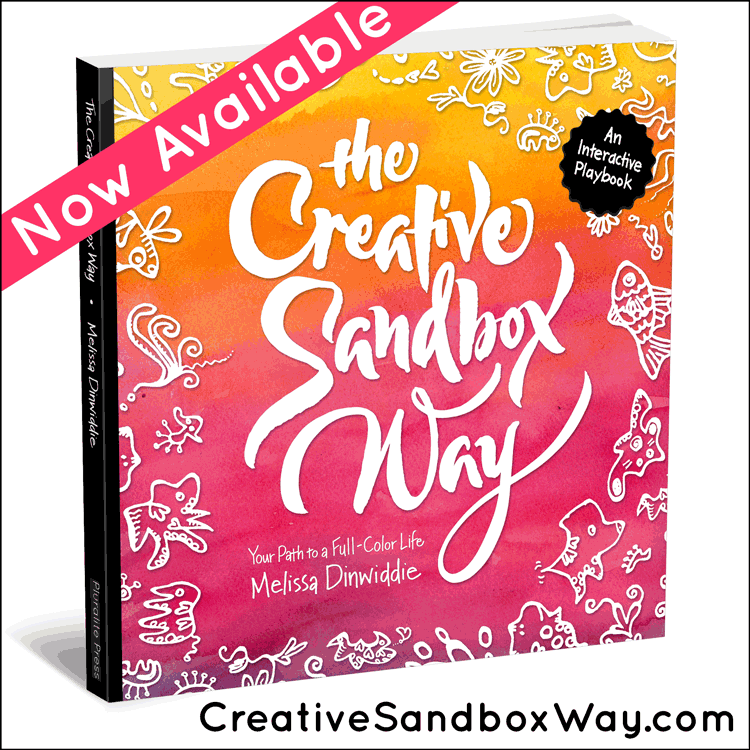



Love, love, love this podcast and this arti in particular. Can you give me any more info on your treadmill desk?! Do you actually type while walking? Love this idea and considering making mine. Pearls of wisdom welcome!
PS since I’ve heard your cat talking on your podcast thought you might want to check out my fabulous animal lover art 🙂 http://www.StaceyLamotheArt.com
Yay! Thanks, Stacey!
You can read more about my treadmill desk here and here. Yes, I do actually type while walking!
It tends to work best when I’m doing straight writing, rather than clicking all over the place, though I’ve done just about everything computer-y while walking. 🙂
Love your fabulous animal lover art!!! <3